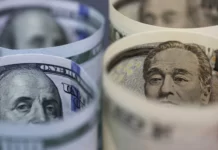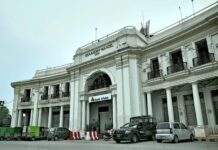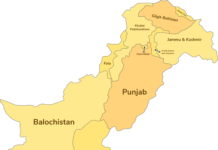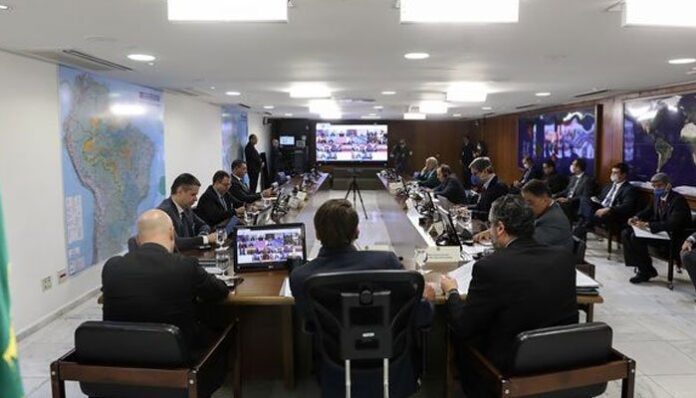WASHINGTON: G20 nations pledged a “united front” Thursday in the fight against coronavirus, saying they were injecting $5 trillion into the global economy to counter the pandemic amid forecasts of a deep recession.
US President Donald Trump and Russian President Vladimir Putin joined the emergency video conference chaired by Saudi Arabia’s King Salman, who called for coordinated action while facing pressure to end an oil price war between Riyadh and Moscow that has roiled energy markets.
The talks come amid criticism that the G20 has been slow to address the COVID-19 pandemic, which has left more than 23,000 dead worldwide and triggered financial shockwaves as more than three billion people are locked down. “We are strongly committed to presenting a united front against this common threat,” the leaders said in a joint statement after the summit.
“We are injecting over $5 trillion into the global economy, as part of targeted fiscal policy, economic measures, and guarantee schemes to counteract the social, economic and financial impacts of the pandemic.”
The figure was a sum total of the fiscal stimulus packages adopted by individual G20 states, the Chinese foreign ministry said, adding that Beijing’s share amounted to $344 billion.
As concerns mount for poorer countries without access to capital markets or adequate health facilities, G20 leaders also pledged to work with bodies such as the International Monetary Fund to deploy a “robust” financial package to support developing nations.
“It is our responsibility to extend a helping hand to developing countries and the least developed countries,” King Salman said.
Putin called for a “moratorium” on sanctions during the pandemic, telling G20 leaders it was a matter “of life and death”. He did not specify which countries should be earmarked for sanctions relief. Russia has faced numerous rounds of Western sanctions following the annexation of Crimea in 2014.
The coronavirus pandemic has forced three billion people into lockdown and claimed more than 23,600 lives with more than 2,370 new deaths and reported over 522,000 cases in 198 countries and territories on Thursday.
With the disease tearing around the globe at a terrifying pace, warnings are multiplying over its economic consequences, and experts say it could cause more damage than the Great Depression.
Amid squabbling between the leaders of China and the US over who is to blame, UN Secretary General Antonio Guterres called for the world to act together to halt the menace. “COVID-19 is threatening the whole of humanity,” he said. “Global action and solidarity are crucial. Individual country responses are not going to be enough.”
The global lockdown — which also took in India´s huge population this week — tightened further Thursday as Russia announced it was grounding all international flights, while Moscow´s mayor ordered the closure of cafes, shops and parks.
Tokyo´s millions of citizens have been told to stay home and tourism-dependent Thailand has shuttered its borders. Economists say the restrictions imposed around the world could cause the most violent recession in recent history.
“The G20 economies will experience an unprecedented shock in the first half of this year and will contract in 2020 as a whole,” ratings agency Moody’s said. Unemployment rates are expected to soar — as much as 30 percent in the US — according to James Bullard, president of the St Louis Federal Reserve.
The devastating effect on poorer nations was laid bare Thursday when the Philippines announced that nine frontline doctors had died after contracting COVID-19. Three large Manila hospitals said this week they had reached capacity and would no longer accept new coronavirus cases. Hundreds of medical staff are undergoing 14-day self-quarantines after suspected exposure, the hospitals said.
The death toll from the virus, which emerged in China late last year, continued to grow, with the US becoming the sixth country to hit four figures.
Almost 1,100 people are now known to have died in the United States, with nearly 70,000 confirmed infections, a tally by Johns Hopkins University showed. Globally the number of infections is closing in on half a million.
The rocketing infection rate in the US has sparked a rush to buy weapons, gun store owners told AFP, with customers panicking about societal breakdown.
“A lot of people are buying shotguns, handguns, AR-15 (semi-automatic rifles), everything,” said Tiffany Teasdale, who sells guns in Washington state. “A lot of people are scared that someone is going to break into their home to steal cash, their toilet paper, their bottled water, their food.”
Around half of the US population is under lockdown, but President Donald Trump said he would decide soon whether unaffected parts of the country can get back to work. “We want to get our country going again,” Trump said. “I´m not going to do anything rash or hastily. By Easter we´ll have a recommendation and maybe before Easter,” he added.
Iran´s death toll surpassed 2,200 Thursday and Spain´s topped 4,000. Iran reported 157 new virus deaths, imposed intercity ban.
Meanwhile health experts cautioned that the sewage-soaked alleyways and bamboo shacks that are home to one million Rohingya refugees in Bangladesh provide fertile ground for the spread of the disease.
Britain’s National Health Service said London´s hospitals faced a “continuous tsunami” of seriously ill COVID-19 patients. In Iran, health ministry spokesman Kianoush Jahanpour also said that 2,389 new cases have been confirmed in the past 24 hours, bringing the total number of declared infections in one of the world´s wost-hit countries to 29,406.
“Fortunately, until today 10,457 of those infected have recovered and been discharged from hospitals,” he told a news conference. COVID-19 could lead to more than 80,000 deaths in the US and overwhelm hospital capacity nationally as soon as early April even if social distancing measures are respected, new research showed Thursday. The US death toll for the pandemic has already soared past 1,100, with 75,600 confirmed infections.
Forecasters at the Institute for Health Metrics and Evaluation (IHME) at the University of Washington´s School of Medicine analysed the latest COVID-19 data at a local, national and international level. These include hospitalisation and mortality rates, as well as patient date in terms of age, gender and pre-existing health problems.
Specifically, they looked at the time lag between the first fatal cases and public interventions such as shuttering schools and businesses. They then looked at each American state´s ICU bed and ventilator capacity.
The analysis warned that based on current trends, demand for both would far exceed capacity for COVID-19 patients as early as the second week of April.
The economic shutdown triggered by the coronavirus pandemic caused an unprecedented 3.3 million people to file for unemployment benefits last week alone. “We hope these forecasts will help leaders of medical systems figure out innovative ways to deliver high-quality care to those who will need their services in the coming weeks,” said Murray.
Greek authorities have quarantined a cluster of Muslim majority towns and villages in the country´s northeast after several cases and a death from the new coronavirus in the area.
The area in Xanthi prefecture was placed in lockdown as of Wednesday evening as nine people in the region overall have tested positive for the virus over the past six days, civil protection deputy minister Nikos Hardalias told reporters. “All residents have been temporarily confined at home. No exceptions are allowed,” Hardalias said. The centre of the outbreak appears to be the small Pomak town of Ehinos, a community of about 2,500. “Ehinos residents will be provided with food and medicine,” Hardalias said.
Police were deployed Thursday on a bridge leading into town to enforce the lockdown, television footage showed.
The Pomaks are a Muslim group of Slavic origin who live mainly in neighbouring Bulgaria. They make up part of Greece´s roughly 110,000-strong Muslim minority in the country´s northeast bordering Turkey.
Meanwhile, the US military has decided it will stop providing some of the more granular data about coronavirus infections within its ranks out of concern that the information might be used by adversaries as the virus spreads.
US Defence Secretary Mark Esper outlined the plan in an interview with Reuters, saying that he wanted the military to keep providing broader data about infections in the armed forces, which rose by 30 percent to 227 cases on Wednesday.
“What we want to do is give you aggregated numbers. But we’re not going to disaggregate numbers because it could reveal information about where we may be affected at a higher rate than maybe some other places,” Esper said, without disclosing precisely what information would be withheld or when the plan would be implemented.
Extending school and work closures at the coronavirus’ ground zero in China may delay a second wave of infections, researchers said on Thursday, urging the rest of the world to take note.
With containment measures largely successful and the epidemic’s epicenter now in Europe, China has loosened a two-month lockdown in the city of Wuhan where the new coronavirus is thought to have jumped from wildlife to people late last year.
But a study in The Lancet Public Health journal suggested continuing Wuhan’s shutdowns until April would push a potential second wave of COVID-19 – the disease caused by the new virus – until later in the year. That would give health services more time to recover and expand, potentially saving lives. “The city now needs to be really careful to avoid prematurely lifting physical distancing measures, because that could lead to an earlier secondary peak in cases,” said Kiesha Prem, a specialist at the London School of Hygiene & Tropical Medicine (LSHTM), who co-led the research. “If they relax the restrictions gradually, this is likely to both delay and flatten the peak.”
The study used mathematical modeling to simulate either extending or relaxing school and workplace closures in Wuhan, a city of 11 million people whose name has become synonymous with the coronavirus for much of the world.
By lifting control measures now, a second rush of infections may occur in late August, the analysis suggested. But keeping lockdown measures until April would likely delay a second peak until October — giving healthcare workers a chance to regroup.
Those findings were “crucial for policy makers everywhere”, said Tim Colbourn, an expert in global health epidemiology at University College London, who was not directly involved in the study.
Stunned by the disease’s rapid spread, governments around the world are trying to replicate China’s draconian lockdown measures while also working out the risk of recurrences once the epidemic peaks have passed in their countries. “Our results won’t look exactly the same in another country,” said Yang Liu, an LSHTM expert who also worked on the research. “But we think one thing probably applies everywhere: physical distancing measures are very useful, and we need to carefully adjust their lifting to avoid subsequent waves of infection. If those waves come too quickly, that could overwhelm health systems.”
























